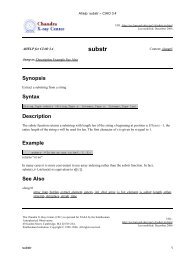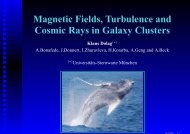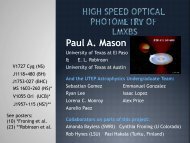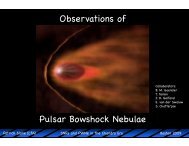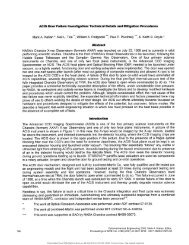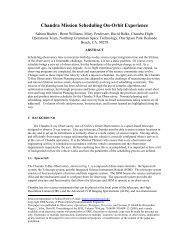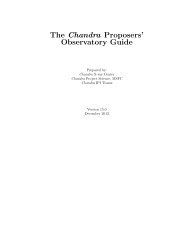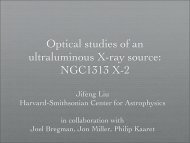PDF Version - Chandra X-Ray Observatory (CXC)
PDF Version - Chandra X-Ray Observatory (CXC)
PDF Version - Chandra X-Ray Observatory (CXC)
You also want an ePaper? Increase the reach of your titles
YUMPU automatically turns print PDFs into web optimized ePapers that Google loves.
14<br />
the rest of the spacecraft. On the ground it was subjected to<br />
subassembly calibration and “burn in” of the microchannel<br />
plates at count rates of thousands to tens of thousands<br />
of counts per second. Aging in orbit occurs when subjected<br />
to the 1700 V or so of tension between top and bottom<br />
microchannel plates during observations. This voltage<br />
serves to amplify the charge liberated by X-ray photon interactions<br />
with the top microchannel plate surface and its<br />
photoelectric effect-enhancing CsI coating. The resulting<br />
electron cascade within the pores of the plates is the signal<br />
that is detected and enhanced by amplifiers connected to<br />
a fine grid of wires situated beneath the plates. The magnitude<br />
of the signal for a given X-ray photon is referred<br />
to as the “pulse height” and is a measure of the gain of the<br />
instrument.<br />
After years of use and bombardment by the ambient<br />
particle background, the plates “age”, losing some<br />
of their photoelectic efficiency. This occurs primarily<br />
through chemical migration in the bottom plate where all<br />
the charge comes from. The net result is likely to be gain<br />
droop. Part of the routine monitoring of the HRC calls<br />
for regular observations of designated calibration sources<br />
whose behaviour is fairly constant and, if not, hopefully<br />
reasonable well-understood. For the HRC-S, the hot DA<br />
white dwarf HZ43 is the standard effective area monitoring<br />
source. It is thought constant and is the brightest source in<br />
the sky over much of the LETG+HRC-S wavelength range,<br />
providing useful signal from 50–170 Å in exposure times<br />
of 20 ks or so. We observe it every year and look<br />
at the count rates as a function of wavelength<br />
and detector position, and examine the pulse<br />
height distributions of the X-ray events.<br />
Since launch we have observed a slow<br />
secular decline in the LETG+HRC-S count<br />
rates from HZ43. This meant either the discovery<br />
of exciting new white dwarf physics in<br />
which HZ43 is cooling at rates orders of magnitude<br />
faster than theory predicts, with startling<br />
implications for both astrophysics and physics<br />
in general. . . or a change in detector performance.<br />
We discovered the QE decline was accompanied<br />
by a slow decline in the event pulse<br />
height distributions—a sure sign of gain droop.<br />
The gain change itself did not matter too much,<br />
other than making the background filter Brad<br />
Wargelin had painstakingly developed based on<br />
X-ray pulse heights entertainingly more com-<br />
plex to implement. The QE decline was slow—<br />
just a bit more than 1% per year—and so practically<br />
inconsequential considering the absolute<br />
precision of the LETG+HRC-S effective area of<br />
about 15%. After accumulating a decade’s worth<br />
<strong>CXC</strong> Newsletter<br />
of data we thought we had the QE decline well-characterized<br />
and included the effect in the <strong>Chandra</strong> calibration<br />
database by means of time-stamped detector quantum efficiency<br />
(QE) files: when generating effective areas for an<br />
observation in CIAO, the appropriate QE file for the time<br />
of the observation is incorporated automatically.<br />
Perhaps unlike human aging, for detector aging<br />
grey is good. We want to see grey changes—changes that<br />
are essentially uniform with wavelength so that complex<br />
secular energy-dependent calibration models do not have<br />
to be constructed. The HRC-S QE decline looked grey,<br />
though at one time one of us who shall remain nameless<br />
(JJD) foolishly lost his house and all its contents on a bet<br />
that it was non-grey. It did in fact look grey until about<br />
two or so years ago, when we noticed that the longer wavelengths<br />
of the latest observed HZ43 spectra seemed slightly<br />
depressed compared with earlier trends. To define the<br />
trend, more data were needed (Fig. 1), and the non-grey<br />
QE drop is now quite obvious.<br />
Why is the QE decline now non-grey? The bombardment<br />
by ambient particles produces photoelectrons<br />
and detectable signal, just as X-ray events do. The pulse<br />
height distribution for particles is quite different to that of<br />
X-ray photon events, and is essentially flat over the pulse<br />
height range of the former. However, most of the particle<br />
events have low pulse heights, and these events cause the<br />
full pulse height distribution to rise strongly at lower values.<br />
To avoid wasting valuable telemetry on these particle<br />
Fig. 1 - Gain droop on the HRC-S leads to loss of valid events in the longest<br />
wavelength channels. This mid-analysis figure made by “no gain without pain”<br />
expert Brad Wargelin shows trends in count rate for HZ43 in different wavelength<br />
regions. Note the relative decline at later times in the gold, red and<br />
magenta curves for λ > 140 Å.



